Grass Fed Organic Ghee: Health Benefits and Uses
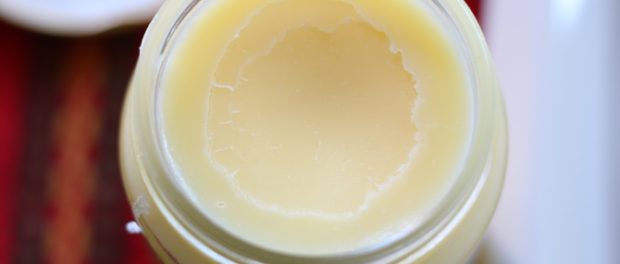
Ghee is probably the healthiest fat in the world. You should use it for cooking, and you can always add it to your juices and smoothies. It will make a great difference! In this post we will see exactly why.
The ancient Vedas devoted a special section to health and healing, and this part was called Ayurveda. The Ayurveda is the foundation text of traditional Indian medicine, and it puts Ghee (clarified butter) at the top of all fats.
And if anyone should know about the functioning of the human body, it should be the ancient Vedic civilization.
A couple of years ago, I started using Ghee as a replacement for vegetable oil.
I wish I had started earlier.
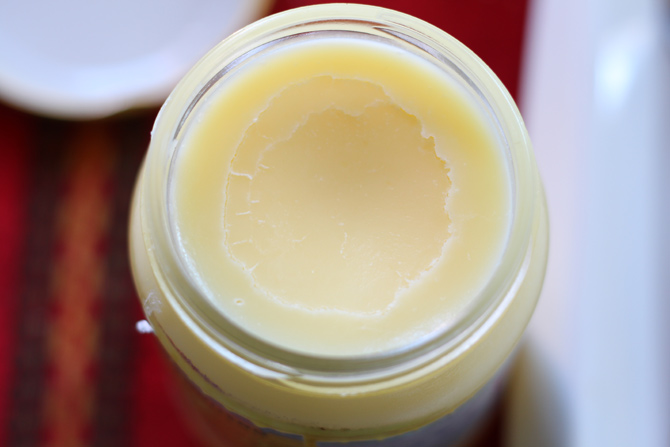
Because I would have spared my body from all those adverse health effects of the unhealthy oils (most of the poly-unsaturated vegetable oils). And, I would have speared the members of my family, too.
Now I know how ignorant I had been… all those years believing that sunflower oil or soy oil can be healthier than butter, or Ghee for that matter.
You see, most of the so called modern vegetable oils are a recent invention. And not a very healthy one. Our ancestors knew only of olive oil, lard, butter, and ghee. And they were much healthier.
After discovering Ghee, I found out that I could make another step toward Organic Grass Fed Ghee. This was important too!
Owing to its delicious composition and really healthy ingredients, I found that grass fed ghee could satisfy both my taste and my search for the healthiest fat I could cook with.
I this post I will indicate the important features and benefits of Ghee, and you too can start using this much better alternative to butter.
Table of Contents
Organic vs Non Organic Ghee?
You can make Ghee from animals raised in intensive farming or industrially grown livestock. But you should avoid this ghee as much as you can.
Why?
Well, because grass is what a cow should eat. Not grains mixed with hormones. Why would you prefer animals fattened on soy, or corn with supplements? This is totally unnatural to them, and they are often forced to live in closed limited spaces. And make no mistake, all toxins from this wrong diet will go into the fat, and ultimately into the ghee.
So search for organic farms that produce great organic grass fed butter, which is then clarified to make Ghee. Unlike these ill-treated animals from the corporative U.S. food industry that give subquality dairy, you should look for dairy from happy, grass fed animals with fewer problems of this type. The Ghee produced using their milk is of superior quality and great nutritional value.
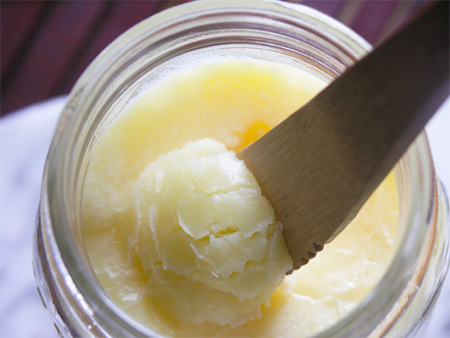
A good indicator of grass fed ghee is the color. The more yellow the color, the more chlorophyll has been transferred to the milk from grass. The animals should graze on grass as much as possible. In winter they should feed on hay and silage, not on grains. These rules ultimately determine the quality of the Ghee.
Nutritional Benefits
As far as the nutrition profile of Ghee goes, it is abundant in calories. But this is no surprise, as this is true for all fats. There is about 110 calories in just one tablespoon of ghee.
The beauty of ghee is that it is obtained through a process of clarification of butter. What does it mean?
It means there is virtually no milk protein (casein), which has been removed in the process of purification. This is a good thing, because many people don’t really digest casein well.
The other good thing is that ghee has no carbohydrates – in this case no lactose. If you are lactose intolerant, ghee can be a perfect solution for you.
Ghee is high in saturated fat. This is a red flag for many people, but my humble opinion is that the dietary guidelines are flawed when it comes to saturated fat.
Ghee contains about 60-65 percent of saturated fat. There is about 32 percent of mono-unsaturated fat, and only a tiny bit of poly-unsaturated fat. This fatty profile is what makes ghee so suitable for cooking, almost no poly-unsaturated fats that spoil easily. It is no surprise then that the smoking point of Ghee is the astonishing 485 degrees F.
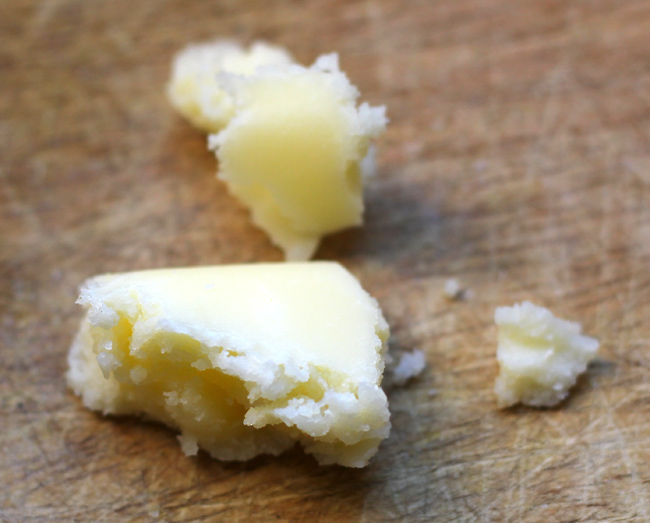
Indeed, much better than butter, or many other oils for that matter.
The saturated fats in Ghee are of shorter, medium, and longer-carbon chain fats. The short and medium fatty acids is what makes ghee much more digestible when compared to lard for example.
It goes without saying that Ghee contains no artificial hydrogenated trans fats.
There are some important vitamins in Ghee. These are from the group of fat soluble vitamins, like A, E, and D, but Ghee will dissolve even the vitamins that come from other foods from outside.
We shouldn’t forget about vitamin K2, which is found in higher concentration in Ghee, than in any other natural food (except for Natto, or fermented soybean). While green leafy vegetables contain vitamin K1, in order to get the extremely important K2 you have to have animal sources. K2 is important if you want to build strong bones. In fact if you don’t want the calcium in your body to be deposited in the wrong places (like the arteries), getting enough K2 is a must.
The butyric acid and caprylic acid in Ghee are both very healthy. They are short chain fatty acids with anti-cancer properties. It inhibits the growth of cancer cells in the digestive system and promotes a healthy epithelial layer. They also promote the growth of healthy bacteria in the intestines, while suppress the growth of parasites and unhealthy bacteria at the same time.
The conjugated linoleic acid (CLA) in Ghee is a natural form of trans fat which is extremely healthy. Unlike the man-made trans fats, it helps in weight loss, prevents the growth of cancer cells, and can be beneficial for the cardiovascular system.
Health Benefits
Ghee is a great fat for young children as it helps developing cognitive functions.
We shouldn’t forget that the brain of an infant is 60 percent fat, and the mother’s milk is 50 percent fat. So, unlike carbs, fat is the natural source of energy for young children.
According to Ayurveda, Ghee is recommended for mental clarity, digestion, ulcers, and skin and eye health. In fact, Ayurveda recommends clarified butter for the entire body, and especially for improving immunity, and dealing with inflammation.
Ghee will increase your vital energy and potency. It is a great lubricant for the connective tissue, like the joints, and helps build cartilage.
Believe it or not, Ghee is alkaline. It is probably the only dairy product that is alkaline!
Usually the foods based on protein and fat are acid forming. But ghee is an exception, and this is due to its short chain fats butyrates and caprylates.
Now there is Ghee, but there is Aged Ghee. I have a friend who swear by aged Ghee, as an universal cure against severe conditions, such as epilepsy and cancer. In India, aged ghee is especially valuable, and some people keep a stash of ghee that goes back hundreds of years. It is expensive and rare, and if you can find some, it is definitely worth giving it a try. It can be a therapeutic substance, although this very old Ghee probably should only be applied topically.
The Traditional Ghee
In order to make traditional Ghee, you would have to have organic, unsalted butter from grass fed cows. You should cook it slowly in a pot, removing the excess milk solid part and water. What should remain is the golden and soft oil, which is then allowed to solidify into a solid fat at room temperature.
According to the ancient tradition of Ayurveda, the best time to prepare Ghee is during waxing moon. The waxing phase represents the qualities of the Divine Mother, and it is this energy exactly that you would like to be transferred to the Ghee for better health benefits.
Yes, Ghee is solid at room temperature. You can keep it out of the refrigerator – it won’t change consistency and it won’t spoil easily. The only thing you should pay attention to is the container. Glass, air-tight container is what is required to minimize the possibility of oxidation and to prevent from coming in contact with moisture.
Ghee is the best cooking oil there is!
It doesn’t burn like butter, and after removing lactose and casein from it, it has a much smoking point.
Add Ghee to Your Juices
Ghee is a perfect addition to your green juices. You really wouldn’t like to drink them without some healthy fat, and one of the healthiest is Ghee. It will help the absorption of the nutrients from the green vegetables, and it will bring its own healthful properties to the final juice. Try it, if you haven’t already.
If You Want to Make Ghee at Home
Making Ghee at home is entirely possible. I won’t go into details here. Instead here is a video describing the necessary steps. If you decide to go this way, make sure you have the right ingredients, that is raw organic butter.
Ghee: Concerns and Side Effects
To tell you the truth, I don’t think there is too much reason for concern. But we all know the usual story about the link between saturated fats and hearth diseases, how unhealthy they supposedly are. And Ghee contains cholesterol. Frankly, I don’t think cholesterol as such is a problem, and I don’t think there is a link between saturated fat and hearth disease.
What’s really a huge concern for me is using the so-called safe, but in fact very much unhealthy, vegetable oils. Especially for cooking.
If you need to follow the official recommendations, you should probably also skip using Ghee, or limit its use. It would be a shame, but that’s your choice.
In India, Ghee has been used for generations thousand and thousands years now. Until 50 years ago nobody knew about heart diseases regardless of the Ghee consumption.
Still, if you have doubts, you should probably use ghee in a moderate fashion. If you have cholesterol problems and/or heart related problem, consult with your physical before using Ghee.
The Best Place to Look For Ghee?
You can find it online on Amazon.com. We love this brand
(100% Organic from Grass-fed Animals) and it has also high marks from users of this product.
The taste is superior vs the other brands. It has a fresh, sweet and rich flavor, and high nutritional value and health benefits.
- This one is rated number 1 for taste and quality.
- It is USDA certified, organic, and Kosher.
- The animals are pastured at the coast of North California, and these grasses are what enables the Ghee’s unique delicious taste.
- Hand made over open flame
- No mass production to ensure premium quality fresh Ghee butter
- The clarification occurs in a slow process to make sure no lactose, casein, or moisture is retained
The Bottom Line
Even if it weren’t for the many health benefits of Ghee, given all the fats available today, it would still be your best choice for High Temperature cooking.
I usually cook on water, but whenever there is no other choice but to fry something, I absolutely use Ghee, alone or in combination with coconut oil (the best ratio of coconut oil vs ghee for frying is roughly 50:50).
Ghee is hands down your best substitute for vegetable oil, butter, and even olive oil. It will give a special aroma to your dishes, to your smoothies and juices. Enjoy!

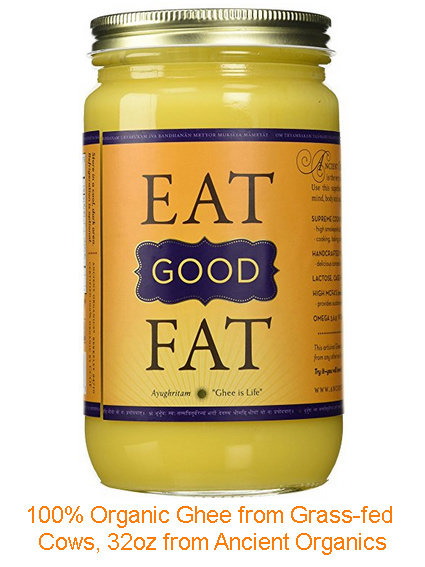
Leave a comment